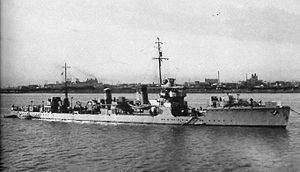Name Tsuga Completed 20 July 1920 Launched 17 April 1920 | Laid down 5 March 1919 Struck 10 March 1945 Construction started 5 March 1919 Builder IHI Corporation | |
 | ||
Fate Sunk by American aircraft, 15 January 1945 | ||
The Japanese destroyer Tsuga (栂) was one of 21 Momi-class destroyers built for the Imperial Japanese Navy (IJN) in the late 1910s. She spent most of the Pacific War patrolling and escorting convoys in and around Chinese waters, during which the ship participated in the Battle of Hong Kong in December 1941. Tsuga was sunk by American carrier aircraft in early 1945.
Contents
Design and description
The Momi class was designed with higher speed and better seakeeping than the preceding Enoki-class second-class destroyers. The ships had an overall length of 85.3 meters (280 ft) and were 83.8 meters (275 ft) between perpendiculars. They had a beam of 7.9 meters (26 ft), and a mean draft of 2.4 meters (8 ft). The Momi-class ships displaced 864 metric tons (850 long tons) at standard load and 1,036 metric tons (1,020 long tons) at deep load. They were powered by two Parsons direct-drive steam turbines, each driving one propeller shaft, using steam provided by three Kampon water-tube boilers. The turbines were designed to produce 21,500 shaft horsepower (16,000 kW), which would propel the ships at 36 knots (67 km/h; 41 mph). The ships carried a maximum of 275 metric tons (271 long tons) of fuel oil which gave them a range of 3,000 nautical miles (5,600 km; 3,500 mi) at 15 knots (28 km/h; 17 mph). Their crew consisted of 110 officers and crewmen.
The main armament of the Momi-class ships consisted of three 12-centimeter (4.7 in) Type 3 guns in single mounts; one gun forward of the superstructure in a well deck, one between the two funnels, and the last gun atop the aft superstructure. The guns were numbered '1' to '3' from front to rear. The ships carried two above-water twin sets of 53.3-centimeter (21.0 in) torpedo tubes; one mount was in the well deck between the forward superstructure and the forward gun and the other between the aft funnel and aft superstructure.
Construction and career
Tsuga, built at the Ishikawajima shipyard in Tokyo, was laid down on 5 March 1919, launched on 17 April 1920 and completed on 20 July 1920.
Pacific War
At the start of the Pacific War on 7 December 1941, Tsuga was assigned to the China Area Fleet with two of her sister ships, Hasu and Huri. She supported the invasion of Hong Kong in December 1941 and then began convoy escort and patrolling off the Chinese coast. The ship was sunk by carrier aircraft from Task Force 38 during its South China Sea raid on 15 January 1945 at coordinates 23°33′N 19°33′E.
